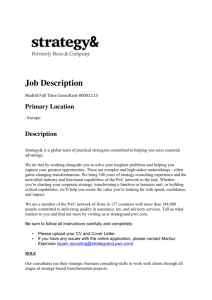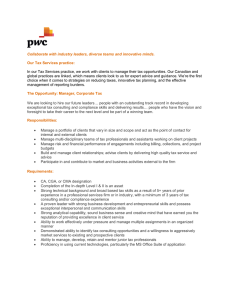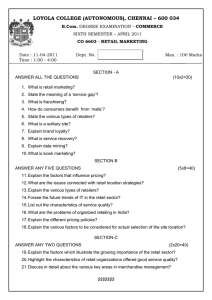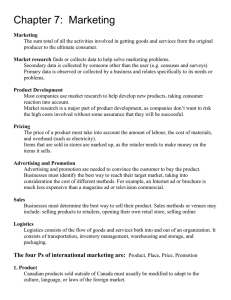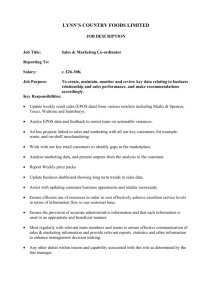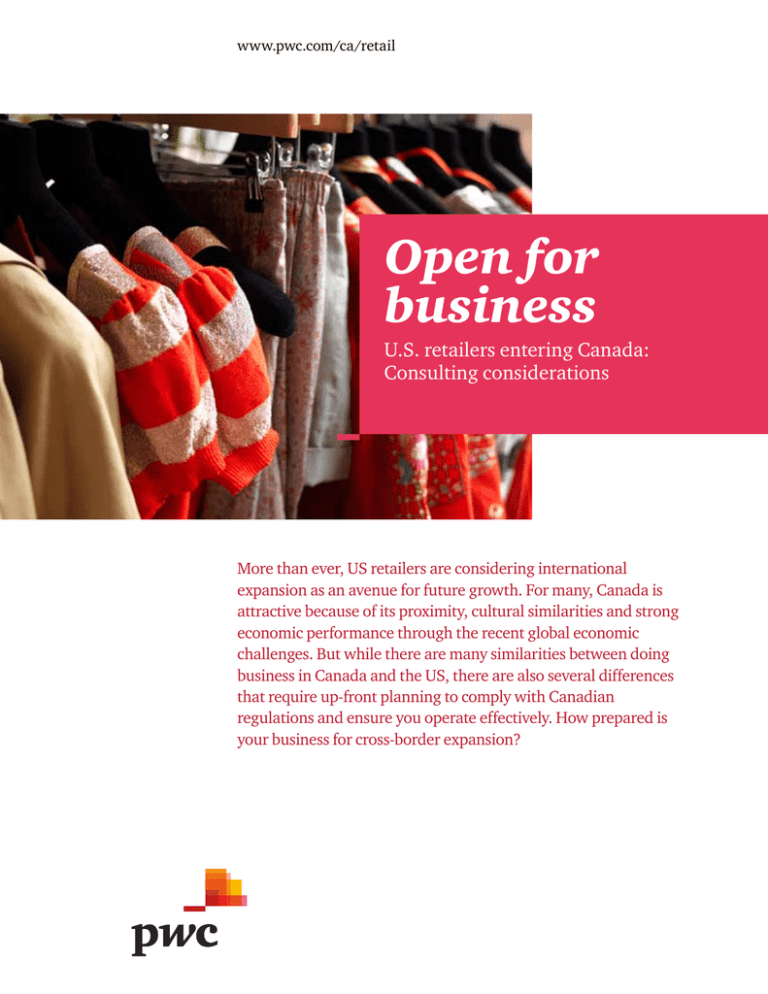
www.pwc.com/ca/retail
Open for
business
U.S. retailers entering Canada:
Consulting considerations
More than ever, US retailers are considering international
expansion as an avenue for future growth. For many, Canada is
attractive because of its proximity, cultural similarities and strong
economic performance through the recent global economic
challenges. But while there are many similarities between doing
business in Canada and the US, there are also several differences
that require up-front planning to comply with Canadian
regulations and ensure you operate effectively. How prepared is
your business for cross-border expansion?
U.S. retailers entering Canada:
considerations
Becoming a smooth operator
Operations
Merchandise optimization
Technology
To successfully cross the border to the north, you’ll
need to understand the competitive landscape and
the needs of Canadian shoppers and translating those
needs into effective merchandising, marketing and
store operations programs. An important part of this
is the ability to make strategic decisions on what
organizational roles, accountabilities and processes
should reside in Canada versus those that could
remain at the corporate office. Are you confident that
your Canadian operating model will leverage the
uniqueness of the Canadian market? Do you have the
right organizational capabilities required to support
expansion?
Protecting your information assets is important
regardless of what country you operate in. Retailers
in Canada should be in accordance with regulation
and compliance guidelines, such as the Personal
Information Protection and Electronics Document
Act (PIPEDA) and the Payment Card Industry Data
Security Standard (PCI DSS). For instance, if your
business is looking to accept debit cards as a payment
method, you are required to use the Interac network
in Canada.
When it comes to product assortment and allocation,
consider the consumer buying habits of Canadians
in different markets and locations. Also take into
account that there is typically less floor space (square
feet) in Canadian retail locations compared to US
stores. All this boils down to one thing: making sure
you have the right products and the right marketing in
the right stores.
Did you know?
Quebec consumers and language laws
The predominantly French-speaking market of Quebec
makes up a significant portion of Canadian consumers.
There are both subtle and obvious differences in Quebecers’
consumer behaviour, which can impact both the range of
products they will buy and the type of advertising they will
respond to. At the same time, retailers must comply with
the Charter of French Language in Quebec. The language
law places strict restrictions: French is mandatory on
product labelling, commercial documentation (catalogues,
pamphlets, brochures and commercial directors) and
commercial signs (promotional signs, displays, etc.). While
other languages can be present, French text must be at least
equal in size to the other languages.
While you may not need large scale systems
integration for your expansion, consider integrating
Canada-specific business applications and selecting
the right technology vendors with strong Canadian
footprints. Choose vendors that can provide retailspecific services, including multilingual call centres
and payment processors, which will help you navigate
potential language and cultural barriers.
Retail loss prevention
Similar to the US, criminal elements are present
in the Canadian retail market. Comprehensive loss
prevention programs that use a well-crafted mix of
cameras, in-store security devices, control procedures
and data analytics can help to combat those who are
at risk to commit crimes.
One significant difference between Canada and the
US is the existence of personal identification number
(PIN) controlled debit cards. While this is considered
to be more secure, it’s not foolproof, and these cards
have become an increasing target for criminals. Train
your store personnel to inspect and validate that
PIN pads located at the point-of-sale have not been
compromised during the day. When there are doubts,
exercise caution and take such PIN pads out of service
to validate their integrity.
From sea to shining sea
Product flow and supply chain
Taking the risk out of risky
Reporting and risk
Distribution
Customs
Financial Reporting
Unlike the US, the majority of the Canadian
population live in five main cities. This
level of concentration can often provide
distribution challenges for US retailers—
from higher transportation costs to supply
chain inefficiencies. The key to getting it
right is to effectively structure your supply
chain so that it’s scalable to grow with your
business strategy over time.
The duty cost of direct shipment of
inventory purchases to Canada should be
compared to that of replenishment through
US distribution centers. US retailers may
be able to take advantage of Canadian
duty relief programs or US foreign trade
zone programs to reduce or recover duty
on cross-border transactions. Other issues
to consider include customs valuations,
tariff classification and duty rates, tariff
treatment (free trade areas), importer
of record, administrative matters (e.g.
appointing a customs broker, establishing
complaint record keeping processes) and
anti-dumping/countervailing duty.
Retailers can experience a number of
complex financial accounting issues related
to matters such as valuations, pensions and
corporate treasury.
Where your stores are located will help you
determine whether to run your distribution
network out of the US or set-up distribution
centres within Canada, and if you should use
a third party distribution centre. In the case
of sourcing from low-cost countries, such
as China and India, it may be more cost and
time effective to import directly to Canada
rather than through a US distribution
centre. Having a Canadian-specific sourcing
and supply chain strategy, which looks at
origin/inbound flow, provincial warehouse
real estate, market coverage of third party
logistics providers and transportation,
can help you focus on optimizing your
distribution network from both a cost and
service perspective.
Did you know?
Liquor and tobacco
Canadian law prohibits tobacco from being sold in places
that provide healthcare and pharmacies and vending
machines. The ability for retailers to sell liquor varies
between provinces. In some provinces you can only
purchase liquor through government and licensed private
stores; in others, grocery and convenience stores are able
to sell liquor.
Before entering Canada, understand the
different reporting and financial standards
in both countries, including SarbanesOxley (SOX) and the Canadian equivalent
for public companies (CSOX). At the same
time, while IFRS is not mandatory for public
companies in the US, all Canadian public
companies are required to implement IFRS
in January 2011. US retailers should also
consider how they plan to develop their
non-financial performance reporting.
Risk and Regulatory
As with any business, it’s important to have
sound internal audit and risk management
functions that deliver more strategic value at
a lower cost of operation. As you bring your
business north, consider the implications
on your controls functions. Many retailers
establish their internal audit and monitoring
activities in centres of excellence while
others set them up in one centralized office,
depending on the needs and geographical
dispersion of the business. This may also
change based on whether or not you operate
through branches or subsidiaries in Canada.
Controls testing, including SOX testing of
internal controls financial reporting and
CSOX, is another key consideration. Finally,
with two official languages in Canada
(English and French), how equipped are
you to operate effectively in both languages
and comply with French language laws in
Quebec?
The bricks and mortar
of doing business
People
Real Estate
Who to call
Employers in Canada must comply with
payroll withholding, remittance and
reporting requirements relating to the
following four main areas, as well as to
personal income tax withholding from
employment income:
Not uncommon in any retail market,
location is key. But since Canada is a vast
geographic country with few main retail
cities, the availability of good retail space
in these cities is limited. Indeed, with 2-3%
vacancies, shopping centres in Canada are
essentially full. It’s important to have a solid
understanding of the value that each of your
retail locations can produce.
Greater Toronto Area
Christopher Kong
National Retail & Consumer Leader
416 869 8739
christopher.p.kong@ca.pwc.com
Similar to in the US, the rent on a leased
space is calculated based on the square
footage of the space in addition to a
percentage of sales.
Tax
Ryan Thulien
416 869 2342
ryan.d.thulien@ca.pwc.com
When it comes to real property tax:
Deals
Carla Eisnor
416 815 5015
carla.eisnor@ca.pwc.com
• Canada Pension Plan (CPP) – mandatory
equal contributions by employers and
employee
• Employment Insurance (EI) – mandatory
employer and employee premiums based
on insurable earnings to a maximum
• Employer health and post-secondary
education premiums for certain provinces
at varying rates applied to total payroll
• Provincial workers’ compensation
premiums, which vary by industry and
experience rating
Environmental concerns
Canada offers a number of environmental
programs and government incentives to
help retailers embrace sustainability and go
green. Environmental levies include:
• Certain provinces and municipalities
impose a transfer tax on the transfer of
real property (land and buildings), which
varies by province.
• Leases could be subject to land transfer
taxes on long-term leases, which varies by
province, for example leases in excess of
50 years in Ontario
• Blue box and recycling programs
(available in several provinces)
• E-waste/hazardous waste
• Tire stewardship
• Plastic bags – in several cities across the
country, retailers are mandated to charge
consumers for plastic bags
Environmental incentives are available
at both the federal and provincial levels,
including for energy conservation and
efficiency. Many of these opportunities are
provided through government agencies,
but some are offered through utility, power
and other companies, often funded through
government agencies.
How we can help
PwC’s Retail and Consumer professionals
can help you successfully expand your
US retail business to Canada. We use our
business, strategy and technology skills and
experience so you can better understand and
navigate the Canadian landscape and market
your business accordingly. Our range of
experience gives us a strong understanding
of the issues retail and consumer companies
face across the entire supply chain, from
manufacturing and distribution to final
consumer purchase.
Call one of our consultants to discuss your
unique needs.
Ross Sinclair
416 228 4000
ross.sinclair@ca.pwc.com
Supply Chain
Lino Casalino
416 815 5263
lino.casalino@ca.pwc.com
Risk & Internal Audit
Dorothy Sanford
416 869 2353
dorothy.a.sanford@ca.pwc.com
Private Company Services
Mauro Fratarcangeli
416 218 1433
mauro.fratarcangeli@ca.pwc.com
Corporate Finance
Keith Mosley
416 941 8307
keith.mosley@ca.pwc.coom
Quebec Region
Alain Michaud
514 205 5327
alain.michaud@ca.pwc.com
B.C. Region
Calle Johnson
604 806 7774
calle.johnson@ca.pwc.com
Retail Consulting Services
Antony Karabus
416 373 4225
antony.karabus@ca.pwc.com
www.pwc.com/ca/retail
© 2011 PricewaterhouseCoopers LLP. All rights reserved. In this document, “PwC” refers to PricewaterhouseCoopers LLP, an Ontario limited liability partnership, which is a member firm
of PricewaterhouseCoopers International Limited, each member firm of which is a separate legal entity. 0807-02 0411


